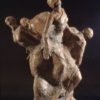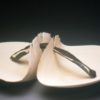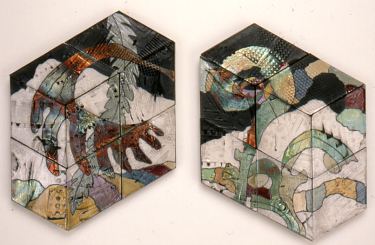Phyllis Pacin
Flora
hand textured hand made tile, raku fired
My love of clay goes back to the first grade and my first clay project, a sombrero ashtray. What I remember most is the smell of the damp clay and the tactile pleasure of wetting the piece to keep the clay soft while I worked. I loved the feel of it – the slippery surface contrasting with the solidity of the underlying form. As I wrapped the piece with a damp cloth and then plastic to put it away, I wondered how I could wait an interminable week to work on it again. The finished piece was a shiny glazed wonder to me. Over the many years that it resided on the breakfast room shelf, I delighted in handling it and feeling its bulges and concavities.
In my three-dimensional art class in high school, I learned various hand-building techniques such as pinch pot forming and slab and coil building. I loved the technical challenges and still have my notes from that class. A pair of slab-built mugs I made that year is still displayed at my parents’ home. To me they remain handsome in terms of proportion, surface texture and glaze color.
In college my interest moved from making round objects to making nonfunctional pieces such as sealed box shapes. I mounted some of these six-sided boxes on the wall, with design elements on their faces only. Eventually, I eliminated the five plain sides, leaving a flat piece of clay on the wall. Some of the pieces had irregular edges; others were geometric.
The work I’ve been doing for the past fourteen years evolved from these earlier wall sculptures. I arrange parallelogram-shaped tiles into architectural compositions that have a trompe l’oeil illusion of three-dimensional form. In the past one and a half years I have continued to explore the transformation of what we see vs. what exists: the visual illusion of my pieces has been transformed further by my “folding” the forms visually so that they look like actual three-dimensional objects existing in real space.
© Phyllis Pacin



